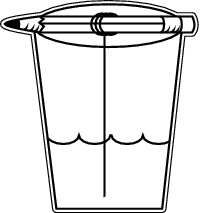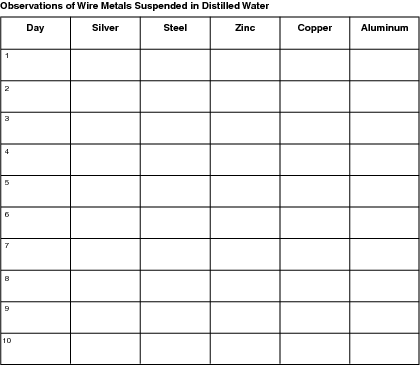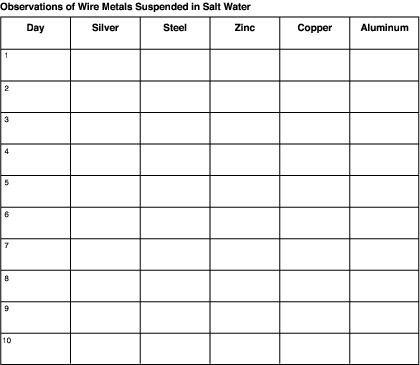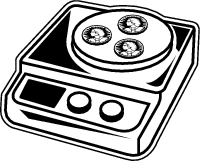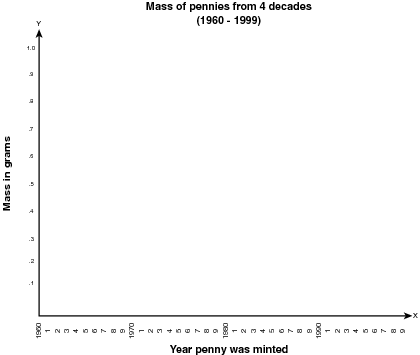Understanding and Using the Scientific Method
The scientific method is the backbone of every science experiment, and understanding it is critical to the success of your science fair experiment.
Three different people can witness the same event, and each come up with a different account of how it occurred. Police and investigators know that this is true; so do parents and teachers. You've probably had some experience with this phenomenon, as well. Have you ever had two friends who attended the same event give you completely different reports of what happened?
These conflicting viewpoints occur because we all see the world differently. We all have beliefs, biases, and perceptions that cause us to view things the way we do.
While these differences are what make us each unique and assure that the world is an interesting place, they can make it difficult to determine what is really true and what isn't.
Scientists over the centuries found they faced the same problems when it came to sorting out the truth from nontruths. To solve the problem, they devised a methodical framework within which to work. This framework is called the scientific method, and it's extremely important to your science fair project.
The Scientific Method Made Easy
The scientific method is a tool that helps scientists—and the rest of us—solve problems and determine answers to questions in a logical format. It provides step-by-step, general directions to help us work through problems.
Basic Elements
The scientific method is a series of steps that serve as guidelines for scientific endeavors. It's a tool used to help solve problems and answer questions in an objective manner.
You probably use the scientific method in everyday life without even realizing it. Let's say that one night you feel like reading in bed, but your mom has already told you three times that it's late and you need to keep your light out and go to sleep.
Because you know you're not going to be able to sleep regardless of what your mom says, you reach under the bed for your handy flashlight and flip the switch to turn it on. Nothing happens.
Now you're faced with the problem of not being able to read because your flashlight doesn't work, and you're not happy about it. Having identified the problem, you think back to the last time your flashlight didn't work, and you remember that it was because of worn-out batteries.
You guess that worn-out batteries are the reason your flashlight isn't working now, so you get some new batteries from the drawer next to your bed and replace the ones in your flashlight. Presto! Your flashlight works.
Standard Procedure
There are two forms of the scientific method, but they both require the same objective reasoning and steps. The experimental method employs numerical data and graphs, while the descriptive method gathers information through visual observation and interviewing. The experimental method generally is used in physical sciences, and the descriptive method in zoology and anthropology.
Without realizing it, you've just worked through the steps of the scientific method to solve a problem.
For our purposes, there are five steps to the scientific method. They are …
- Identify a problem.
- Research the problem.
- Formulate a hypothesis.
- Conduct an experiment.
- Reach a conclusion.
When your flashlight wouldn't turn on, you knew you had a problem. That took care of the first step. Your research (the second step) was conducted when you thought back to the last time your flashlight didn't work and remembered that you needed new batteries. You completed the third step by coming up with the hypothesis (an educated guess) that you needed new batteries this time, as well.
You conducted your experiment (the fourth step) when you replaced the batteries and turned the flashlight on. When the flashlight worked, you reached the conclusion that indeed, it had needed new batteries. You completed the fifth step of the scientific method and proved your hypothesis to be correct. You also got to finish that great book you were reading!
So you see, the scientific method is not mysterious or difficult, although you can use it to work through some difficult problems.
Don't Even Think About Not Using It
There's no question that you must use the scientific method when you do your science fair project. Nearly every science fair has rules that clearly state that the scientific method must be observed and followed. Not following the method's steps could cause you to arrive at incorrect results, and could make your entire project invalid.
Using the scientific method assures that you'll work objectively, not subjectively. That means that you won't bring to the project your personal, preconceived thoughts about what you think should or should not happen, or your own interpretations of your observations and data. The scientific method assures that you'll stick to “just the facts.” You'll employ objective reasoning instead of subjective reasoning. The difference, when it comes to science projects, is extremely significant.
What is objective reasoning, and how does it compare to its subjective cousin? Simply, objective reasoning is when you recognize that there's a problem, then use research and experimentation to solve it. Sort of like when your flashlight didn't work. You thought about (researched in your head) the problem, then experimented by replacing the batteries. And, ultimately, you solved the problem.
Had you reacted subjectively, however, you would have recognized the problem of the flashlight not working, but you may have come to an invalid conclusion based on emotions or some bias instead of figuring out that you needed new batteries. Maybe you would have assumed that the flashlight wasn't working because it was red, and you always hated the color red.
Suffice it to say that when you're working on a science fair project, or dealing with any scientific problem, the scientific method, which encourages objective reasoning, is the only way to go.
Whoever Thought of the Scientific Method, Anyway?
The scientific method probably is the cumulative result of hundreds of years of scientific pondering and people working to make sense out of what goes on around us.
Scientific Surprise
Francesco Redi was a man of many talents. In addition to his scientific work, he worked as a doctor, and was also a poet and writer. As a doctor, he stressed the importance of a balanced diet.
A scientist often credited with being the first to employ the scientific method—although he wouldn't have called it that—is Francesco Redi, an Italian physician who lived from 1626 until 1697.
Redi's work to disprove spontaneous generation is often credited as the first modern experiment, and was conducted within the parameters of what we now call the scientific method. Basically, Redi disagreed with the then-popular notion that some species appeared spontaneously in nonliving matter.
As odd as it seems to us, people believed for hundreds of years that certain species could be grown from nonliving materials. Some people, for example, thought that if you put worn, sweaty underwear in an open jar with some husks of wheat and let it sit for a few weeks, the sweat from the undies would penetrate the husks of wheat and turn the wheat kernels into (are you ready?) mice. Weird, huh?
Redi's work, however, didn't involve underwear and mice, but rotting meat and maggots. It was widely believed in those days that maggots appeared spontaneously from rotting meat. Redi, however was convinced from his research, which consisted primarily of observing activity surrounding rotting meat, that the maggots resulted from the eggs that visiting flies deposited on the meat.
He hypothesized that the maggots came from the eggs of flies, and set out to prove that he was right. Redi set up an experiment in which some meat was left uncovered, some was partially covered, and some was sealed so that nothing could get to it.
As you probably guessed, no maggots appeared on the sealed meat, because no flies could reach it. Redi's hypothesis was shown to be correct, and the roots for the scientific method had taken hold.
Stating the Problem
The first step when using the scientific method is to state the problem you'll be attempting to solve. This step is sometimes referred to as “stating your purpose.” You're identifying the purpose of the project, which is to solve a problem or answer a particular question.
In a science fair project, you deliberately identify and state the problem you're attempting to solve. In everyday life, you probably do the same thing in a more informal way. Did you ever ask yourself (or someone else) why your neighbor's grass is really green, and yours is sort of brown with lots of weeds in it?
Standard Procedure
Try to be aware of how you may identify problems as they occur in everyday life. Chances are that you'll find yourself using a simpler version of the scientific method to solve problems and answer questions on a daily basis.
Or why you got an 88 percent in the last math test, and your best friend only got a 74 percent? Every time you ask a question of this sort, you're stating a problem. You can probably go ahead and solve these types of problems by doing some informal research, making a guess, and checking to see if you're right.
You may learn, for instance, that your neighbor has been fertilizing his lawn, and your best friend forgot to take his math book home the night before the test.
When you state your problem or question, be sure not to make it so broad that it becomes unmanageable. Try to focus in and make your problem specific. This will help you to find a starting point in solving it.
For instance, stating your problem as “In what conditions do plants grow best?” is so broad and general that it would be almost impossible to know how to begin working through a project.
But, if you ask, “Do bean plants grow better in direct sunlight, indirect sunlight, or shade?” you've narrowed down your problem to address only one type of plant, and one factor affecting its growth.
Also, be sure that your problem is one that can be solved through experimentation. Solving the bean plant problem stated above can easily be accomplished through a controlled experiment. A controlled experiment is when you test a variable against a control.
Researching Your Topic
Once you've stated your problem, you'll probably need to do a bit of research before you formulate your hypothesis.
At this point, you'll be refining your research to specifically address the problem you've stated. This will allow you to put forth an intelligent and well thought out hypothesis, which is simply an educated guess about the results of your project.
Remember to document your research, and use a variety of sources. Don't forget that your previous experiences and knowledge you already have can be valuable additions to your research.
Coming Up with a Hypothesis
Basic Elements
A hypothesis is an educated guess about the outcome of your experiment, based on knowledge that you have and research you've conducted.
The third step of the scientific method is formulating a hypothesis. All this means is that you'll need to come up with a statement concerning the predicted results of your experiment. It's what you think will happen, based on the research you've done and your knowledge. A hypothesis doesn't include why you think you'll get certain results, just what you think they will be.
The more you know about your problem, the better equipped you'll be to come up with a logical hypothesis.
Giving It Your Best Guess
Your hypothesis should be clearly and simply stated, and should be in statement form—not a question. If you're guessing about the growth of the bean plants, for instance, the following statement is an example of a clear, concise hypothesis:
- Bean plants will grow better in direct sunlight than in indirect sunlight or shade.
Because it's understood that a hypothesis is an educated guess, you don't need to say that you're guessing. You needn't say, for example, “I think that bean plants will grow better in direct sunlight than in indirect sunlight or shade.”
Remembering That It's Only a Guess
So what happens if you state your hypothesis, only to find out after the experiment that it's wrong? Nothing.
Explosion Ahead
If your hypothesis turns out to be incorrect, resist the temptation to change it. This defeats the purpose of using the scientific method. An incorrect hypothesis will not affect the quality of your project.
Guessing incorrectly the results of your experiment doesn't make the experiment wrong, or any less valuable than if your hypothesis turned out to be correct. Your hypothesis isn't necessarily the answer to your problem. It's simply a statement of what you think will happen.
Testing Your Hypothesis
The experiment that you conduct will be to test your hypothesis. Your experiment will be designed around your hypothesis, and will either prove or disprove it.
It will be important to conduct your experiment with your hypothesis in mind. However, it's imperative that you don't engineer your experiment to prove that your hypothesis is correct. You can't for instance, add Miracle-Gro to the direct-sunlight bean plants to assure that they'll grow better than the other plants. If you do, you'll be helping along your hypothesis, but invalidating the results of your experiment.
Gathering the Materials You'll Need
Explosion Ahead
Using materials you already have is convenient and economical, but just be sure that it's also safe. If your experiment calls for pouring boiling water into a glass beaker, for instance, don't substitute a lightweight, plastic cup, just because you happen to have one in your home.
As with any project, it's important that you have all the materials you'll need to conduct it properly. Just as you wouldn't begin making a recipe without first making sure you have all the ingredients, you shouldn't begin your experiment without making sure you have what you need.
Of particular importance will be having the proper tools for measuring. Many projects require careful, accurate measuring. Most tools for measuring aren't fancy or expensive, but they're essential for conducting an experiment properly. Important measuring tools include tape measures, metric rulers or meter sticks, measuring spoons and cups, thermometers, and clocks or watches with second hands.










